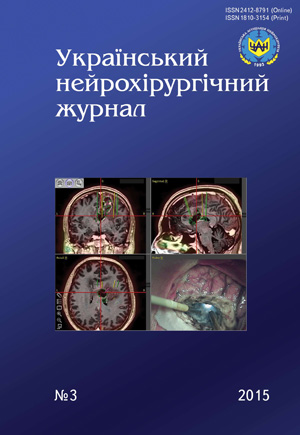The frequency of detection of DNA of Herpesvirus 4 types in brain tumours
DOI:
https://doi.org/10.25305/unj.50115Keywords:
brain tumours, gliomas, human herpesvirus type 4Abstract
Objective. To study the frequency of identifying DNA of human herpesvirus type 4 (Epstein-Barr virus – EBV) in different brain tumours.
Materials and methods. Following the surgical resection, 89 samples of brain tumours were analyzed by real time PCR (“DNA technology” commercial kit) for the presence of EBV DNA.
Results. EBV DNA was detected in about 40% of the samples of different brain tumours. The frequency of EBV DNA in the samples of extracerebral tumours was higher than in intracerebral glial tumours. EBV DNA positivity in benign gliomas was superior to that in malignant ones. The mechanisms of EBV infection of tumour cells in the brain and the role of EBV in stimulation of tumour growth have not been yet elucidated.
Conclusion. EBV DNA is detected in the cells of brain tumours of different histology, prevalently in glial tumours.
References
1. Vasilyeva IG. Biomolekulyarnyye mekhanizmy razvitiya gliom [Biomolecular mechanisms of glioma]. In: Zozulya YuA., editor. Gliomy golovnogo mozga [Brain gliomas]. Kiev: EksOb; 2007. p.35-91. Russian.
2. Lisyany AI. Soderzhaniye onkogennykh virusov v medulloblastomakh i gliomakh golovnogo mozga [The content of oncogenic viruses in medulloblastoma and gliomas of the brain]. In: Abstract Book of International Conf.; 2014, Kiev, Ukraine. Kiev, 2014. p.34-36. Russian.
3. Lisyany NA, Klyuchnikova AI, Lisyany AN. Soderzhaniye tsitomegalovirusa vo vnutrimozgovykh glial'nykh opukholyakh razlichnoy stepeni anaplazii [The content of cytomegalovirus in glial intracerebral tumors of different degree of anaplasia]. In: Abstract Book of International Conf.; 2014, Kiev, Ukraine. Kiev, 2014. p.37-38. Russian.
4. Cobbs CS, Harkins L, Samanta M, Gillespie GY, Bharara S, King PH, Nabors LB, Cobbs CG, Britt WJ. Human cytomegalovirus infection and expression in human malignant glioma. Cancer Res. 2002;62(12):3347-3350. [PubMed]
5. Moore P, Chang Y. Why do viruses cause cancer? Highlights of the first century of human tumour virology. Nat Rev Cancer. 2010;10(12):878-889. [CrossRef] [PubMed]
6. Soroceanu L, Cobbs C. Is HCMV a tumor promoter?. Virus Res. 2011;157(2):193-203. [CrossRef] [PubMed]
7. Scheurer M, Bondy M, Aldape K, Albrecht T, El-Zein R. Detection of human cytomegalovirus in different histological types of gliomas. Acta Neuropathol. 2008;116(1):79-86. [CrossRef] [PubMed]
8. Khominsky B.S. Gistologicheskaya diagnostika opukholey tsentralnoy nervnoy sistemy [The histological diagnosis of central nervous system tumors]. Moscow: Medizdat; 1969. Russian.
9. Louis DN, Ohgaki H, Wiestler OD, Cavenee WK, editors. WHO Classification Of Tumours Of The Central Nervous System. Lyon: IARC; 2007.
10. Louis DN, Ohgaki H, Wiestler OD, Cavenee WK, Burger PC, Jouvet A, Scheithauer BW, Kleihues P. The 2007 WHO Classification of Tumours of the Central Nervous System. Acta Neuropathol. 2007;114(2):97-109. [CrossRef] [PubMed]
11. Cinatl J, Vogel J, Kotchetkov R, Wilhelm Doerr H. Oncomodulatory signals by regulatory proteins encoded by human cytomegalovirus: a novel role for viral infection in tumor progression. FEMS Microbiol. Rev. 2004;28(1):59-77. [CrossRef] [PubMed]
12. Shen Y, Zhu H, Shenk T. Human cytomegalovirus IE1 and IE2 proteins are mutagenic and mediate "hit-and-run" oncogenic transformation in cooperation with the adenovirus E1A proteins. Proc. Nat. Acad.Sci. 1997;94(7):3341-3345. [CrossRef] [PubMed]
13. Melnick M, Sedghizadeh P, Allen C, Jaskoll T. Human cytomegalovirus and mucoepidermoid carcinoma of salivary glands: Cell-specific localization of active viral and oncogenic signaling proteins is confirmatory of a causal relationship. Exp. Mol. Pathol. 2012;92(1):118-125. [CrossRef] [PubMed]
14. Poltermann S, Schlehofer B, Steindorf K, Schnitzler P, Geletneky K, Schlehofer J. Lack of association of herpesviruses with brain tumors. J. Neurovirol. 2006;12(2):90-99. [CrossRef] [PubMed]
Downloads
Published
How to Cite
Issue
Section
License
Copyright (c) 2015 Nikolay Lisianyi, Antonina Klyuchnikova, Oleksandr Lisianyi, Lyudmila Belska, Tatyana Malysheva

This work is licensed under a Creative Commons Attribution 4.0 International License.
Ukrainian Neurosurgical Journal abides by the CREATIVE COMMONS copyright rights and permissions for open access journals.
Authors, who are published in this Journal, agree to the following conditions:
1. The authors reserve the right to authorship of the work and pass the first publication right of this work to the Journal under the terms of Creative Commons Attribution License, which allows others to freely distribute the published research with the obligatory reference to the authors of the original work and the first publication of the work in this Journal.
2. The authors have the right to conclude separate supplement agreements that relate to non-exclusive work distribution in the form of which it has been published by the Journal (for example, to upload the work to the online storage of the Journal or publish it as part of a monograph), provided that the reference to the first publication of the work in this Journal is included.









